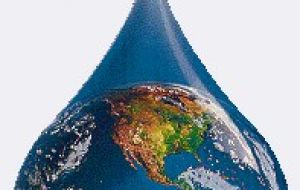MercoPress. South Atlantic News Agency
Drastic reduction of glaciers in the Northeast sector of Antarctic Peninsula
 A “World Water Day” is celebrated March 22 around the globe
A “World Water Day” is celebrated March 22 around the globe There is a continuous and drastic reduction in all of the glaciers located in the Northeast sector of the Antarctic Peninsula,” Argentine glaciologist Pedro Skvarca told local media last week.
Skvarca, a leader of the Glaciological Division of the Trans-Andean Antarctic Institute, has worked for 38 years in Argentine bases and since 1994 has been a direct observer of the melting process in the Larsen ice barrier, which once lined the Antarctic’s entire eastern coast, from North to South.
The collapse of the Larsen ice barrier started with a 1,600km loss of land mass in the summers of 1994 and 1995, in a matter of just two weeks, a phenomenon known as Larsen A. Then, in the summer of 2001, another large chunk of ice twice the size of the previous one broke off as well, coined Larsen B.
Larsen then continued to lose about 20 km of mass between 2007 and 2009, and what remains today is an unstable trace of the former great ice barrier.
Other glaciers such as Boydell and Sjogren have lost 73km, receding from the land line (where the ocean ends) nine and 11 km, respectively, toward the interior.
“In this sector we have calculated the loss of almost 400km of ice that have already begun contributing to higher ocean levels,” said Skvarca.
The scientist recalled that in 1978 his U.S. colleague, John Mercer, first warned that the disintegration of the barriers at both sides of the Antarctic Peninsula would signal a very serious warming process, a phenomenon that has begun much sooner than Skvarca and most of the climate community initially expected. “These events have happened so fast that the scientific community was not prepared,” he said.
Natural phenomena like these, along with the breaking off of a colossal iceberg the size of Luxembourg from the Mertz Glacier on February 26, call attention to two issues Chile and the world must deal with in the future: how handle rising sea levels and the coming scarcity of fresh water.
Skvarca’s affirmation of continued, rapid glacier melt came just days before March 22 World Water Day event.
World Water Day, a United Nations initiative started in 1992 to raise general awareness of 21st century water issues, will be marked by conventions and scholarly discussion around the world. In Santiago the Comité Chileno para el Programa Hidrológico Internacional (CONAPHI) held its Water Day commemoration Monday in the Humberto Fuenzalida Auditorium at the University of Chile’s School of Physical Sciences and Mathematics, located at 850 Beauchef.
By Aaron Cantu - Santiago Times




Top Comments
Disclaimer & comment rulesCommenting for this story is now closed.
If you have a Facebook account, become a fan and comment on our Facebook Page!